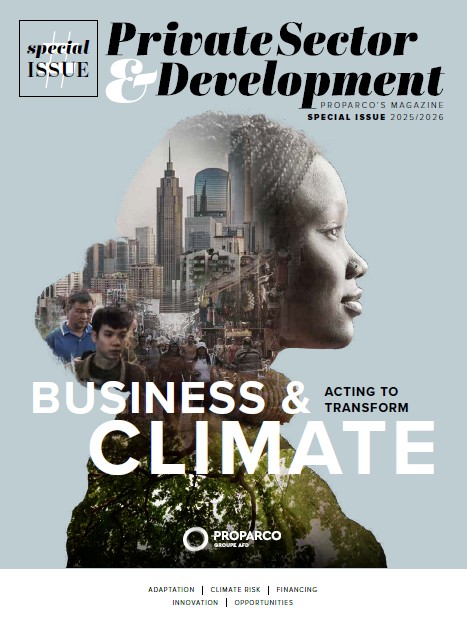Share the page
Financial institutions’ climate role: from commitments to action
Published on
- Sarah Bendahou Research Fellow Development Finance Institute for Climate Economics (I4CE)
- Blandine Arvis Research Fellow Development Finance Institute for Climate Economics (I4CE)


Private Sector & Development - Business & Climate: Acting to transform
Proparco has published a new edition of its Private Sector & Development magazine, focusing on the strategic role of the private sector and financial institutions in tackling the climate emergency.
Financial institutions, including banking and funding institutions, have a pivotal role to play in driving low-emissions and climate-resilient development. They need to adopt practices that support climate mainstreaming in local financial systems, from committing to climate strategies to improving their climate performance. Support from development finance institutions often proves to be an enabling or even a crucial factor.
Developing climate strategies is a critical first step to defining financial institutions’ contributions to the achievement of global climate objectives. In line with existing guidance (e.g. ISSB standards on climate-related disclosures), financial institutions can address the following areas when committing to climate strategies:
- Developing a climate governance strategy, which requires raising awareness and building the capacity of board members on climate-related issues, to enable board oversight of climate target achievements. To go a step further, KPIs and internal incentives for board members can be linked to climate performance.
- Integrating climate considerations in a financial institution’s strategy, which can be materialised by developing a transition plan demonstrating how the institution will achieve its climate-related targets. Most advanced institutions also seek to integrate climate considerations into both their overarching strategy and across their sector, country, and business-line strategies.
- Developing climate-related targets, which in addition to a commitment from top management to align with climate goals, will need to consist of targets such as increasing investments in activities with positive climate impacts and reducing investments in activities with negative impacts. These targets ideally need to be regularly reviewed and updated.
- Building the capacity of management and operational teams on climate-related topics, as a first step towards implementing climate-related strategic objectives. Developing internal guidance and processes to support implementing the climate goals defined in the strategy should then follow. Similar to board member performance incentives – and to go a step further – KPIs and internal incentives for management and operational teams can be linked to climate performance.
Managing climate-related risks
Assessing and managing exposure to climate-related financial risks requires mapping exposure to both transition and physical risks. Development finance institutions can provide technical assistance to support this exercise. The detailed assessment of climate-related risks of assets and transactions has two components: exposure to acute and chronic physical risks, on the one hand (e.g. acute risks such as extreme weather events, and chronic risks such as sea level rise), and exposure to climate-related transition risks, on the other (e.g. carbon pricing, shifts in energy use to lower-emission sources, reputation risk, etc.).
Financial institutions already well advanced in the assessment and management of climate-related risks could consider how risk analyses might feed into risk management processes as well as deal origination for both mitigation and adaptation finance.
Promoting climate-smart objectives
A financial institution has to define climate-related objectives that are relevant to its operations. This does not entail reducing financed emissions as a primary objective, but rather seeking to identify how institutions can further contribute to the transition to low-emissions and climate-resilient economies. These objectives should build on existing national or regional sustainable finance taxonomies, as appropriate. They can be of the following three types:
- Increasing climate-related activities and investments, through climate-related products and services, as a first step (e.g. green bonds or sustainability-linked bonds). For the most advanced financial institutions, this target could translate into engagement and business development with clients and market segments that contribute to achieving climate goals.
- Accessing and mobilising new sources of climate finance, both public and private (e.g. by becoming a Green Climate Fund-accredited entity), to increase the climate investment share of financial institutions’ investments. Financial institutions can benefit from support by development finance institutions, for instance, by developing risk-sharing financial instruments that help mobilise additional finance.
- Reducing activities with adverse climate impact by, first, defining exclusion lists for activities with adverse climate impacts (for instance, coal, upstream oil and gas) and strategies to divest from such activities. Financial institutions can then take a step further by engaging with their clients on climate-related risks and opportunities.
Improving climate performance
Assessing and monitoring climate performance starts by tracking activities and investments that are inconsistent with climate goals, the volume or share of activities and investments that reduce greenhouse gas emissions, and the volume or share of activities and investments that build climate resilience.
Accounting for climate action
Reporting on climate action involves publicly disclosing climate performance, depending on how it is being tracked by financial institutions, in addition to exposure to climate-related risks and, for those at the most advanced stages, the impacts of their climate-related activities and investments.
How can development finance institutions help?
A recent survey by the European Investment Bank (EIB) and the Latin American Association of Development Financing Institutions (ALIDE) found that a lack of know-how concerning green investment and climate change adaptation among clients remains a barrier to scaling up green projects in Latin America and the Caribbean.
Technical assistance provided by development finance institutions to develop tools and build staff capacity is unanimously seen as valuable for financial institutions in driving alignment with the Paris Agreement. Support for impact assessment, monitoring and evaluation, as well as project preparation ranked as the highest priorities for technical assistance among surveyed members of Finance in Common , a global network of public development banks. Technical assistance to help navigate sustainability reporting requirements and support financed emissions tracking is also a recurring request from financial institutions. It helps build capacity for self-assessment of climate performance, enabling improvement over time, and ultimately allows financial institutions to account for their climate action, as appropriate.
Through technical assistance, development finance institutions can also contribute to reducing upfront costs and improving programme efficiency for climate-relevant market segments where financial institutions are engaging for the first time. It helps them increase their share of activities and investments, reduce greenhouse gas emissions, and build climate resilience.
Looking back on financial institutions collaborating on climate objectives
The Inter-American Development Bank’s private sector arm (IDB Invest) provides technical assistance to its private sector counterparties, including local financial institutions . Through this technical assistance, IDB Invest aims to improve the identification of climate project opportunities prior to investment, including through capacity building on climate; to support market develop - ment, through demonstration effects; to attract private investors, by supporting the structuring of blended finance operations and by facilita - ting the production and provision of knowledge to guide investor decision-making.
Outside of multilateral development banks, development finance institutions such as British International Investment (BII) also provide technical assis - tance to financial institutions on climate-related issues. For instance, BII helps financial institutions further mainstream climate into their operations, manage climate risks, and improve their reporting practices. It also provides technical assistance to financial institutions requiring support for climate investments.
Other examples of technical assistance projects include supporting financial institutions in developing tools that sustain project assess - ment frameworks. For instance, the Brazilian Development Bank (BNDES) received support from KfW in calculating avoided emissions from projects, by providing analysts with avoided emissions indicators for their operations. In another example, EIB supported FONPLATA in developing a system to assess project alignment with sustainable development goals (SDGs), providing clear information throughout the project lifecycle
Development finance institutions can also support financial institutions by co-developing climate risk assessment tools. An example of this is IDB’s support for mapping the climate risk vulnerabilities in key value chains in Mexico and Brazil. The tool helped identify the main climate risks and the most exposed regions and agricultural chains within FIRA’s (Trust Funds for Rural Development of Mexico) portfolio. This, in turn, helped deliver more targeted investments to build climate resilience. Another example is Proparco’s support for climate-re - lated transition and physical risk assessments for financial institutions that benefit from broader climate-related technical advisory services, for instance through its Pro Climate programme.
Why is it important for financial institutions to act now?
Many financial institutions already see the business opportunity in financing climate invest - ments, and some have significantly increased such investments over the past years, most notably in renewable energy development. This will however not be sufficient in the face of the global challenges the world is facing. For instance, scientists have warned that even a 1.5°C warming scenario – which is no longer within reach according to most recent studies – could cost up to USD 63 billion in adaptation and residual damage to major crops 5 , among other climate impacts.
Financial institutions must join forces for capital to be directed towards the achievement of global climate change objectives. They have a key role to play in enabling decarbonisation and climate resilience in local economies and societies, by allocating their investments to where it is both profitable and beneficial for broader sustainable development.





